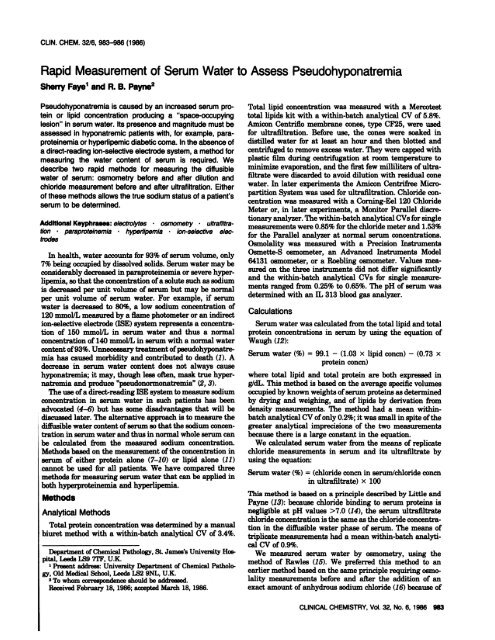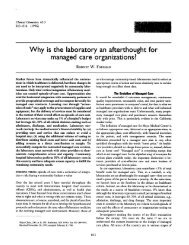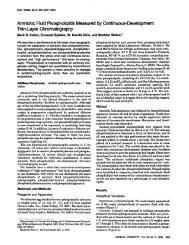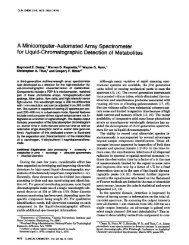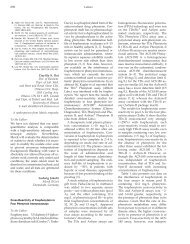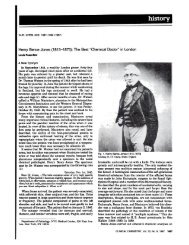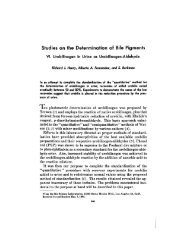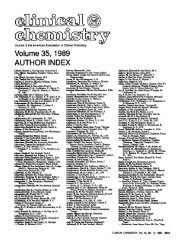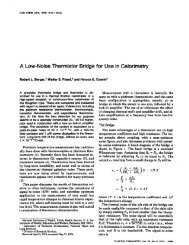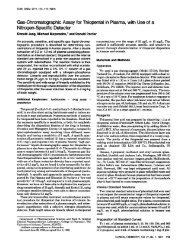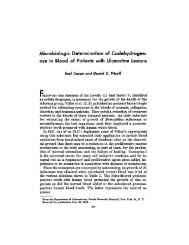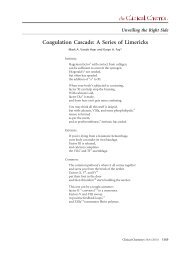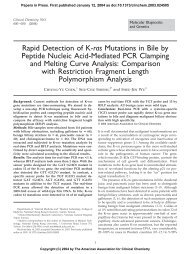Rapid Measurementof Serum Water to ... - Clinical Chemistry
Rapid Measurementof Serum Water to ... - Clinical Chemistry
Rapid Measurementof Serum Water to ... - Clinical Chemistry
Create successful ePaper yourself
Turn your PDF publications into a flip-book with our unique Google optimized e-Paper software.
CLIN. CHEM. 32/6, 983-986 (1986)<br />
<strong>Rapid</strong> <strong>Measuremen<strong>to</strong>f</strong> <strong>Serum</strong> <strong>Water</strong> <strong>to</strong> AssessPseudohyponatremia<br />
Sherry Faye1 and R. B. Payne2<br />
Pseudohyponatremia is caused by an increased serum protein<br />
or lipid concentration producing a “space-occupying<br />
lesion” in serum water. Its presence and magnitude must be<br />
assessed in hyponatremic patients with, for example, paraproteinemia<br />
or hyperlipemic diabetic coma. In the absence of<br />
a direct-reading ion-selective electrode system, a method for<br />
measuring the water content of serum is required. We<br />
describe two rapid methods for measunng the diffusible<br />
water of serum: osmometry beforeand afterdilutionand<br />
chloride measurement before and after ultrafiltration. Either<br />
of these methods allows the true sodium statusof a patient’s<br />
serum <strong>to</strong> be determined.<br />
AdditIonal Keyphrases: electrolytes osmometry ultrafiltration<br />
paraproteinemia . hyperlipemia ion-selective electrodes<br />
In health, water accounts for 93% of serum volume, only<br />
7% being occupied by dissolved solids. <strong>Serum</strong> water may be<br />
considerablydecreased in paraproteunemia or severe hyperlipeima,<br />
so that the concentration of a solute such as sodium<br />
is decreased per unit volume of serum but may be normal<br />
per unit volume of serum water. For example, if serum<br />
water isdecreased <strong>to</strong> 80%, a low sodium concentrationof<br />
120 mmol/L measured by a flame pho<strong>to</strong>meter or an indirect<br />
ion-selective electrode USE) system represents a concentration<br />
of 150 mmol/L in serum water and thus a normal<br />
concentration of 140 minol/L m serum with a normal water<br />
content of 93%. Unnecessary treatment of pseudohyponatremia<br />
has caused morbidity and contributed <strong>to</strong> death (1). A<br />
decrease m serum water content does not always cause<br />
hyponatremia; it may, though less often, mask true hypernatremia<br />
and produce “pseudonormonatremia” (2, 3).<br />
The use of a direct-reading ISE system <strong>to</strong> measure sodium<br />
concentration in serum water in such patients has been<br />
advocated (4-6) but has some disadvantages that will be<br />
discussed later. The alternative approach is <strong>to</strong> measure the<br />
diffusible water content of serum sothat the sodium concentration<br />
in serum water and thus normal whole serum can<br />
be calculated from the measured sodium concentration.<br />
Methods based on the measurement of the concentrationin<br />
serum of either protein alone (7-10) or lipid alone (11)<br />
cannot be used for all patients. We have compared three<br />
methods for measuring serum water that can be applied in<br />
both hyperproteinemia and hyperlipeniia.<br />
Methods<br />
Analytical Methods<br />
Total proteinconcentration was determined by a manual<br />
biuret method with a within-batch analytical CV of 3.4%.<br />
Department of Chemical Pathology,St. James’sUniversity Hospital,<br />
LeedsLS9 7FF, U.K.<br />
‘Present address:University Department of Chemical Pathology,<br />
Old Medical School, Leeds LS2 9NL, U.K.<br />
2To whom correspondenceshouldbe addressed.<br />
Received February 18, 1986; acceptedMarch 18, 1986.<br />
Total lipid concentration was measured with a Mercotest<br />
<strong>to</strong>tal lipidskitwith a within-batch analytical CV of 5.8%.<br />
Amicon Centriflo membrane cones, type CF25, were used<br />
for ultrafiltration. Before use, the cones were soaked in<br />
distilled water forat leastan hour and then blotted and<br />
centrifuged <strong>to</strong> remove excesswater. They were capped with<br />
plastic film during centrifugation at room temperature <strong>to</strong><br />
minimize evaporation,and the first few milliliters of ultraifitrate<br />
were discarded <strong>to</strong> avoid dilution with residual cone<br />
water. In later experiments the Amicon Centrifree MicropartitionSystem<br />
was used for ultrafiltration. Chloride concentration<br />
was measured with a Corning-Eel 120 Chloride<br />
Meter or, in later experiments, a Moni<strong>to</strong>r Parallel discretionary<br />
analyzer. The within-batch analytical CVs for single<br />
measurements were 0.85% for the chloride meter and 1.53%<br />
for the Parallel analyzer at normal serum concentrations.<br />
Osmolality was measured with a Precision Instruments<br />
Osmette-S osmometer, an Advanced Instruments Model<br />
64131 osmometer, or a Roebling osmometer. Values measured<br />
on the three instruments did not differ significantly<br />
and the within-batch analytical CVs for single measurements<br />
ranged from 0.25% <strong>to</strong> 0.65%. The pH of serum was<br />
determined with an IL 313 blood gas analyzer.<br />
Calculations<br />
<strong>Serum</strong> water was calculated from the <strong>to</strong>tal lipid and <strong>to</strong>tal<br />
protein concentrationsin serum by using the equationof<br />
Waugh (12):<br />
<strong>Serum</strong> water (%) = 99.1 - (1.03 x lipid concn) - (0.73 X<br />
protein concn)<br />
where <strong>to</strong>tal lipid and <strong>to</strong>tal protein are both expressed in<br />
g/dL. This method is based on the average specific volumes<br />
occupied by known weights of serum proteins as determined<br />
by drying and weighing, and of lipids by derivation from<br />
densitymeasurements. The method had a mean withinbatch<br />
analytical CV of only 0.2%;it was small in spite of the<br />
greater analytical imprecisions of the two measurements<br />
because there is a large constant in the equation.<br />
We calculated serum water from the means of replicate<br />
chloride measurements in serum and its ultrafiltrate by<br />
using the equation:<br />
<strong>Serum</strong> water (%) = (chloride concn in serum/chloride concn<br />
in ultrafiltrate) x 100<br />
This method is based on a principle described by Little and<br />
Payne (13): because chloride binding <strong>to</strong> serum proteins is<br />
negligible at pH values >7.0 (14), the serum ultrafiltrate<br />
chloride concentration is the same as the chloride concentration<br />
in the diffusible water phase of serum. The means of<br />
triplicate measurements had a mean within-batch analytical<br />
CV of 0.9%.<br />
We measured serum water by osmometry, using the<br />
method of Rawles (15). We preferred this method <strong>to</strong> an<br />
earlier method based on the same principle requiring osmolality<br />
measurements before and after the addition of an<br />
exact amount of anhydrous sodium chloride (16) because of<br />
CLINICALCHEMISTRY, Vol. 32, No. 6, 1986 983
its technical simplicity. <strong>Serum</strong> was diluted with an equal<br />
volume ofwater and replicate measurements oftheosmolality<br />
of the original and diluted serum were made <strong>to</strong> determine<br />
mean values. The calculation is:<br />
<strong>Serum</strong> water (%) = osmolality of diluted seruml(osmolality<br />
- diluted osmolality) x 100<br />
The basis of this method is that, when a solution containing<br />
a “space-occupying lesion” caused by proteins and lipidsis<br />
diluted with an equal volume ofwater,the reductioninthe<br />
concentration of crystalloids dissolved in the aqueous phase,<br />
and therefore the reduction in the measured osmolality, is<br />
greater than that predicted from the volumes mixed so that<br />
the true volumes of aqueous phase mixed, and therefore<br />
serum water, can be determined. With use of the means of<br />
duplicate measurements, the method had a mean withinbatch<br />
analytical CV of 1.3%.<br />
Results<br />
Preliminary Investigation of the Chloride Method<br />
A pooled serum was ultrafiltered in a Centriflo cone and<br />
the <strong>to</strong>tal protein and chloride concentrations of successive<br />
aliquots of the ultrafiltrate and retentate were measured.<br />
The concentrations of chloride in successivefiltrates did not<br />
differ significantly, and they were protein-free. There was a<br />
closenegative linear correlation between the concentrations<br />
in the retentate of protein, which increased from 60 <strong>to</strong> 140<br />
g/L, and of chloride (r = -0.993). The Deming regression<br />
equation for the retentate values was:<br />
Chloride (mmol/L) = 114.3 - (<strong>to</strong>tal protein (in g/L) x 0.178)<br />
The intercept value agreed well with the ultrafiltrate chloride<br />
concentration of 114.1 mmol/L. The constancy offiltrate<br />
chloride concentration was confirmed by prolonged ultrafiltration<br />
of a further six sera (Table 1). The pH values for all<br />
pools of labora<strong>to</strong>ry sera examined exceeded 7.72. We concluded<br />
that there is negligible binding of chloride <strong>to</strong> protein<br />
in separated sera at the pH reached after exposure <strong>to</strong> room<br />
air, as predicted from the observations of Carr (14).<br />
Recovery Experiments<br />
Pooled serum from blood donors was centrifuged in a<br />
number of Centriflo cones and the ultrafiltrates and retentates<br />
were pooled. The pooled retentate had nearly twice the<br />
protein concentration of the original pool and therefore had<br />
a low water content. Retentate was mixed with ultrafiltrate<br />
in the proportions 2:1, 1:1, 2:3, and 1:2, and the serum water<br />
concentrations of the retentate and its dilutions with ultraifitrate<br />
were determined eight <strong>to</strong> 10 times by each of the<br />
Table 1. Chloride Concentrations in Retentate and<br />
Filtrate during Prolonged Ultrafiltration of Six<br />
Labora<strong>to</strong>ry Sera<br />
Chloride concn, mmol/L<br />
15-mmcentrlfugatlon 45-mmcentrltugatlon<br />
Retentate Filtrate Retentate Filtrate<br />
97<br />
97<br />
98<br />
95<br />
96<br />
95<br />
114<br />
114<br />
113<br />
114<br />
114<br />
114<br />
68<br />
71<br />
71<br />
67<br />
68<br />
71<br />
984 CLINICAL CHEMISTRY, Vol. 32, No. 6, 1986<br />
114<br />
114<br />
114<br />
114<br />
114<br />
114<br />
three methods. <strong>Water</strong> accounted for was calculated as the<br />
difference between the mean percentage water in the concentrated<br />
serum and the product of the mean percentage<br />
water in the dilution and the relative volume of ultrafiltrate<br />
added. Least-squares regression analysis of serum water<br />
recovered vs serum water (ultrafiltrate) added gave correlationcoefficients<br />
>0.9997 in each case and the regression<br />
equations were:<br />
<strong>Water</strong> recovered (Waugh) =<br />
<strong>Water</strong> recovered (chloride) =<br />
<strong>Water</strong> recovered (Rawles) =<br />
(0.9901 x<br />
0.0580<br />
(0.9967 x<br />
1.0293<br />
(1.0293 x<br />
0.1420<br />
water added) -<br />
water added) -<br />
water added) -<br />
The slope, and therefore recovery, by Waugh’s protein/lipid<br />
equation was significantly less than 1.0 (p
‘0 0<br />
w E<br />
0<br />
0<br />
E<br />
L<br />
.l<br />
E<br />
98<br />
96<br />
94<br />
92<br />
90<br />
88<br />
86 -<br />
I I I I<br />
3:7 4:6 5:5 6:4 7:3<br />
Relative volumes of added water and serum<br />
Fig. 1. <strong>Serum</strong> water (%) by the osmoiality method in six sera as a<br />
function of relativevolumesof added water and serum<br />
triplicate chlorideconcentrationsmeasured in a Moni<strong>to</strong>r<br />
Parallel analyzer in the original sera and in their ultrafiltrates.<br />
<strong>Serum</strong> water was calculated by the method of Rawles<br />
(15) and by our modification of Rawles’ method from the<br />
mean of duplicate osmolality measurements. The calculated<br />
serum water concentrations did not differ significantly between<br />
the chloride method and our modified osmolality<br />
method (p = 0.90; paired t-test), but were significantly<br />
greater (p =0.0016) by Rawles’ osmolality method(Table 2).<br />
Can Ultrafiltration Be Used <strong>to</strong> Measure <strong>Serum</strong> <strong>Water</strong><br />
Sodium?<br />
Binding of sodium <strong>to</strong> serum proteins at pH 7.5 has been<br />
reported (18) and would be expected <strong>to</strong> increase with increasing<br />
pH. The pH values of our separated serum specimens<br />
all exceeded 7.72.We ultrafiltered eight labora<strong>to</strong>ry<br />
sera, using Centriflo systems as above. While the chloride<br />
concentrationsaveraged 8.1 mmol/L higher in the ultrafiltrates<br />
than in the whole sera (p
5. Swaminathan R, Morgan DB. Pseudohyponatraemia [Letter].<br />
Lancet 1981i:96.<br />
6. Jamieson MJ. Hyponatraemia. Br Med J 1985;290:1723-8.<br />
7. Darrow DC, Hopper EB, Cary MK. Plasmaphoresis edema II.<br />
The effect of reduction of serum protein on the electrolyte pattern<br />
and calcium concentration. J Clin Invest 1932;11:701-15.<br />
& Gilligan DR. Volk MC, Blumgart HL. Observation on the<br />
chemical and physical relationship between the bloodserum and<br />
body fluids: 1. The nature of edema fluids and the evidence<br />
regarding the mechanism of edema formation. J Clin Invest<br />
1934;13:365-81.<br />
9. McLean FC, Hastings AB. The state of calcium in the fluids of<br />
the body. 1. The conditions affecting the ionization ofcalcium. J Biol<br />
Chem 1935;108:285-322.<br />
10. Eisenxnan AJ, McKenzie LB, Peters JP. Protein and water of<br />
serumand cellsofhuman blood,with a noteonthe measuremen<strong>to</strong>f<br />
red blood cell volume.J Biol Chem 1936;116:35-45.<br />
11. Steffes MW, Freier EF. A simple and precise method of determining<br />
true sodium, potassium, and chloride concentrations in<br />
hyperlipemia. J Lab Clin Med 1976;88:683-8.<br />
12. Waugh WH. Utility of expressing serum sodium per unit of<br />
water in assessinghyponatremia. Metabolism 1969;18:706-12.<br />
13. Little AJ, Payne RB. The measurement of protein-binding<br />
using dried polyacrylamide. Protides Biol Fluids Proc Colloq<br />
1973;21:643-7.<br />
14. CaIT CW. Studies on the binding of small ions in protein<br />
solutions with the useof membraneelectrodes.ifi. Thebinding of<br />
chloride ionsin solutionsofvarious proteins. Arch BiochemBiophys<br />
1953;46:417-23.<br />
15. Rawles JM. Severe hyponatraemia in hyperlipaemic diabetic<br />
ke<strong>to</strong>sis. Br Med J 1973;i:357.<br />
16. Albrink MJ, Hald PM,Man EB, PetersJP. The displacement of<br />
serum water by the lipidsofhyperlipemic serum. A newmethodfor<br />
966 CLINICAL CHEMISTRY, Vol. 32, No. 6, 1986<br />
the rapid determination of serum water. J Clin Invest<br />
1955;34:1483-8.<br />
17. Terepka AR, Chen PS, Toribara TY. Ultrafiltration: A conceptual<br />
model and a study of sodium,potassium, chloride and water<br />
distribution in normal serum. PhysiolChem Phys 1970;2:59-78.<br />
18. Carr CW. Studies on the binding of small ions in protein<br />
solutions with the use of membraneelectrodes.VI. The binding of<br />
sodium and potassium ions in solutionsof various proteins. Arch<br />
Biochem Biophys 1956;62:476-84.<br />
19 Payne RB, Levell MJ. Redefinition of the normal range for<br />
serum sodium. Clin Chem 1968;14:172-8.<br />
20. Gill GV, Flear CTG. Hyponatraemia.RecentAdv ChinBiochem<br />
1985;3:149-76.<br />
21. Cowell DC, McGrady PM. Direct-measurement ion-selective<br />
electrodes: analytical error in hyponatremia. Clin Chem<br />
1985;31:2009-12.<br />
22. Czaban JD, Cormier AD, Legg KD. Establishing the directpotentiometric“normal”<br />
range for Na/K residual liquid junction<br />
potential and activity coefficient effects. Clin Chem 1982;28:1936-<br />
45.<br />
23. Maas AHJ, Siggaard-Andersen 0, Weisberg HF, Zijlstra WG.<br />
Ion-selective electrodes for sodium and potassium: a problem of<br />
what is measured and what should be reported. Clin Chem<br />
1985;31:482-5.<br />
2& BuckleyBM, Brough<strong>to</strong>nPMG, RussellLI, Carter TJN. New<br />
ways with old ions. Ann Chin Biochem 1984;21:75-7.<br />
25. Brough<strong>to</strong>n PMG, Smith SCH, Buckley BM. Calibration of<br />
direct ion-selective electrodes for plasma Na <strong>to</strong> allow for the<br />
influence of protein concentration [Letter]. Clin Chem<br />
1985;31:1765-6.<br />
26. Burgess ED, Schnurr LP, Wilkes P. Ion-selective electrodes and<br />
inaccurate serum sodium measurements [Letter]. Ann Intern Med<br />
1985;103:806.


